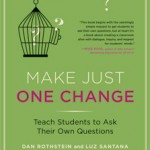 Today I’m talking to Sara Armstrong about Good Questions. Before I attended Sara’s session at the Fall CUE conference on Good Questions Good Searching, I thought I was asking good questions. Now I know I wasn’t going deep enough. Sara shared a book, Make Just One Change, that opened her eyes to a new path that is straightforward to help us ask good questions. So I decided to ask Sara about the book, the process, and why it is important to use this process in teaching and learning. Info about the book with discount code if you want to purchase it is at the end of this post.
Today I’m talking to Sara Armstrong about Good Questions. Before I attended Sara’s session at the Fall CUE conference on Good Questions Good Searching, I thought I was asking good questions. Now I know I wasn’t going deep enough. Sara shared a book, Make Just One Change, that opened her eyes to a new path that is straightforward to help us ask good questions. So I decided to ask Sara about the book, the process, and why it is important to use this process in teaching and learning. Info about the book with discount code if you want to purchase it is at the end of this post.
Q.Why are good questions important?
A. Good questions really help us think deeply about a topic. When we develop a project for PBL, good questions drive the process that kids go through to understand the topic. This processes laid out in Make Just One Change provide specific ways for teachers and kids to think more broadly than in the past — techniques that can be applied in all areas of the curriculum.
Q. Can good questions help students be more responsible for their own learning?
A. By empowering students to get to good questions, we can help them make better choices for good research, they can organize their work, and they will begin to think more critically. Actually students can use this process to determine the path or topic they are pursuing in any curriculum area. And the role of the teacher is vital. The authors, Rothstein and Santana, specify a process to help teachers refine the topic so it is not too broad or too narrow. Teachers, too, get better at their role of posing the main theme for kids to spark their brainstorming aspect to getting to the good questions.
Q. Can teachers use this process with existing curriculum?
A. Yes. Any curriculum. Any time. As we’re trying to instill more responsibility for students, the classroom changes to include more student voice and choice about anything they are learning. It doesn’t matter if we’re talking math concepts, cyberbullying or any topic, students can learn from their peers when they ask each other good questions about the topic. I had trouble with learning geometry and wishes she had had the ability to ask good questions with her peers. When a teacher allows discussions about the topic and asks “how are we going to do it?” students own their learning and are more engaged in the process.
Q. What is the questioning process?
A. The process involves meta-cognitive, divergent, and convergent thinking. Here’s a condense version:
- The teacher defines a topic.
- Students discuss the rules for brainstorming.
- Students brainstorm questions about the topic.
- Students prioritize the questions.
- Students analyze questions as open or closed and then prioritize those.
- Students use the questions to help research, complete their project, and learn the material.
- Students and the teacher reflect on the process, what they learned, and what they would do differently next time.
 Sara highly recommends this book and is designing how to use good questions for good searching and good research. That will definitely be another post. Thank you Sara!
Sara highly recommends this book and is designing how to use good questions for good searching and good research. That will definitely be another post. Thank you Sara!
Interested in this book, go to http://www.hepg.org/hep/book/144 and mention sales code MJAP11 for a 20% discount. If you have any questions, you can leave comments here are contact Sara directly at saarmst@telis.org or go to her website (www.sgaconsulting.org)
The authors of Make Just One Change, Dan Rothstein and Luz Santana of the Right Question Institute, shared a new podcast from Harvard Education Press. Harvard EdCast: Make Just One Change.



[…] your students to brainstorm and prioritize questions about the topic. This post on Making Just One Change where I interviewed Sara Armstrong helped me understand the importance of inquiry. Michael Wesch […]